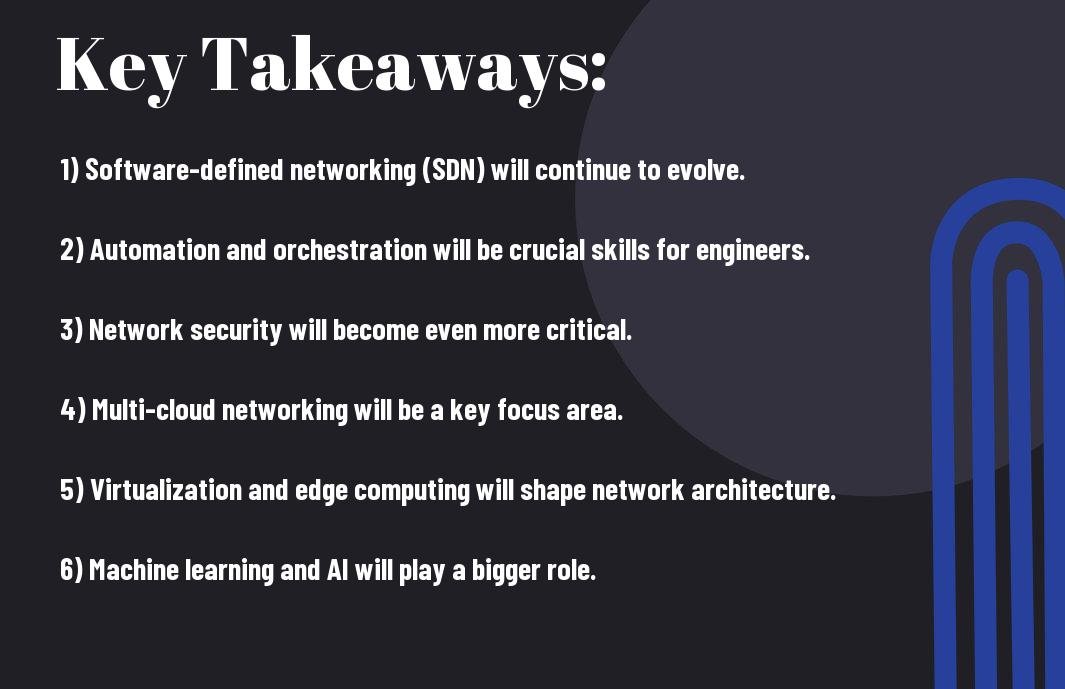Network engineering is an ever-evolving field, and with the rapid advancements in technology, it is crucial to stay ahead of the curve. In this blog post, we will delve into trends and innovations that are shaping the future of network engineering. From 5G and edge computing to automation and security challenges, the landscape of network engineering is undergoing significant changes that will impact businesses, industries, and daily life.
As we navigate through this technological revolution, it is essential for network engineers to stay informed about the latest developments and emerging technologies that will define the future of networking. By understanding these trends and innovations, network engineers can position themselves as innovators and leaders in their field, ensuring they are well-equipped to tackle the challenges and opportunities that lie ahead.
Key Takeaways:
- Automation and Orchestration: The future of network engineering lies in increased automation and orchestration of network operations, enabling more efficient management and faster response to incidents.
- Software-Defined Networking (SDN): SDN is a key trend to watch, as it offers greater flexibility, scalability, and control over network infrastructure through software-based solutions.
- Virtualization and Cloud Computing: Network engineers should focus on enhancing their knowledge of virtualization and cloud computing technologies to meet the increasing demand for cloud-based networking solutions.
- Security and Compliance: With the rise of cyber threats, network engineers need to prioritize security and compliance, ensuring the protection of sensitive data and adherence to regulatory requirements.
- Emerging Technologies: Keeping an eye on emerging technologies such as 5G, IoT, and AI will be crucial for network engineers to stay ahead and adapt to the evolving landscape of networking.

The Rise of Artificial Intelligence and Machine Learning in Network Operations
Some of the most impactful innovations in the field of network engineering are being driven by artificial intelligence and machine learning. These technologies are revolutionizing the way network operations are managed and secured, paving the way for more efficient, reliable, and secure networks.
AI-driven Predictive Analytics
On the forefront of this trend is the use of AI-driven predictive analytics to proactively identify and address network issues before they escalate. By analyzing vast amounts of network data in real time, AI algorithms can detect patterns and trends that indicate potential problems, allowing network administrators to take preemptive action and prevent downtime and performance issues.
Machine Learning for Network Security
Analytics and machine learning are also being applied to network security, enabling organizations to better detect and respond to security threats. By continuously learning from network behavior and identifying anomalous patterns, machine learning algorithms can effectively detect and mitigate security breaches in real time.
Rise in the use of AI-driven security solutions marks a turning point in network security, providing a more robust defense against cyber attacks and unauthorized access.
Automating Network Configuration and Management
Operations are also being transformed through the automation of network configuration and management tasks. AI-powered algorithms are capable of dynamically adjusting network settings and proactively optimizing network performance based on changing demands and conditions.
Intelligence provided by these technologies not only simplifies the network management process, but also leads to more efficient and adaptable network infrastructures, capable of meeting the demands of the modern digital landscape.
Advancements in Network Infrastructure
After years of gradual progress, network infrastructure is on the cusp of a significant transformation. As technology continues to evolve, the future of network engineering promises to embrace several key advancements that will shape the landscape of communication and connectivity.
The Growth of 5G and Beyond
Growth in the realm of network infrastructure is being driven by the rapid expansion of 5G technology, promising faster and more reliable connections for both consumer and enterprise networks. With the increasing demand for high-speed data and low-latency communication, 5G is set to revolutionize the way devices and machines interact, paving the way for innovations such as autonomous vehicles and smart cities.
In addition to 5G, the industry is already looking beyond to even faster and more efficient wireless technologies, including the potential for 6G and beyond, promising unprecedented levels of connectivity and communication infrastructure.
Software-Defined Networking (SDN) Revolution
On the software side, the revolution in network infrastructure is being driven by Software-Defined Networking (SDN), offering greater flexibility and control over network resources. SDN enables the decoupling of control and data planes, allowing for centralized management, simplified network provisioning, and dynamic traffic optimization.
Plus, the rise of SD-WAN (Software-Defined Wide Area Networking) is further transforming network infrastructure by providing organizations with the ability to centrally manage and optimize their wide area networks, streamlining operations and reducing costs.
The Impact of Quantum Computing on Network Encryption and Security
With the potential of quantum computing on the horizon, network encryption and security are facing a paradigm shift. The immense computational power of quantum computers poses a threat to traditional encryption methods, potentially rendering them obsolete and vulnerable to attacks.
Network engineers and security professionals are thus challenged to develop quantum-resistant encryption algorithms to mitigate the risks posed by quantum computing, ensuring the continued confidentiality and integrity of sensitive data transmitted over networks.
The Integration of IoT in Network Engineering
Your network engineering strategy must now account for the integration of IoT (Internet of Things) devices. The proliferation of IoT devices has transformed the way networks are designed, deployed, and managed. This chapter explores the impact of IoT on network engineering and the trends and innovations to watch in this space.
Scaling Networks for the IoT Explosion
Networks must be prepared to accommodate the massive influx of IoT devices. The explosion of IoT devices will place unprecedented demands on network infrastructure, requiring engineers to design and deploy scalable and flexible networks capable of handling the surge in connected devices. This entails rethinking traditional network architectures and leveraging technologies such as SDN (Software-Defined Networking) and NFV (Network Functions Virtualization) to scale networks dynamically in response to IoT growth.
The scalability and flexibility of networks will be crucial in accommodating the exponential increase in IoT devices, ensuring reliable connectivity and optimal performance for diverse IoT applications.
Enhancing Network Connectivity and Performance for IoT Devices
Scaling networks alone is not sufficient. Enhanced network connectivity and performance are essential for IoT devices to transmit and receive data seamlessly. This requires prioritizing low-latency communication and reliable connectivity for IoT devices across heterogeneous networks. Technologies such as 5G and edge computing will play a vital role in empowering IoT devices with enhanced network connectivity and performance.
The IoT explosion necessitates a robust focus on optimizing network connectivity and performance to support diverse IoT applications and ensure seamless data transmission across the network.
Addressing IoT Security Challenges in Network Design
Designing secure networks is paramount as the integration of IoT introduces new security challenges. Network engineers must prioritize implementing robust security measures to safeguard IoT devices and networks against potential threats. This involves adopting secure-by-design principles and integrating advanced security technologies to mitigate IoT-specific cybersecurity risks.
Network design must align with IoT security best practices to defend against evolving cybersecurity threats and protect sensitive IoT data across the network.
Cloud Computing and Network Engineering Synergy
Despite the advancements in network engineering, the integration of cloud computing has reshaped the landscape of network infrastructure. Cloud computing and network engineering have formed a powerful synergy that is driving innovation and transforming the way businesses operate.
Cloud-native Networking: Principles and Advancements
Synergy between cloud computing and network engineering has led to the emergence of cloud-native networking principles and advancements. This approach leverages the dynamic and scalable nature of cloud infrastructure to build and manage networks. By embracing cloud-native networking, organizations can achieve agility and flexibility in network operations, paving the way for rapid deployment and automation of networking resources.
Hybrid and Multi-cloud Network Strategies
One of the key outcomes of the synergy between cloud computing and network engineering is the evolution of hybrid and multi-cloud network strategies. These strategies enable organizations to seamlessly integrate resources across different cloud environments, ensuring resilience and redundancy. By leveraging a combination of public, private, and edge clouds, businesses can optimize performance and cost-effectiveness, while mitigating the risks associated with vendor lock-in and data sovereignty.
Cloud computing plays a pivotal role in enabling hybrid and multi-cloud network strategies by providing the infrastructure and platform for seamless orchestration and management. With the rise of cloud-native technologies, organizations can achieve a level of interoperability and portability across diverse cloud environments, empowering network engineers to design resilient and efficient architectures.
Cloud-based Network Management and Security Solutions
Computing
Cloud-native

Cybersecurity Trends in Network Engineering
For network engineers, staying ahead of cybersecurity threats is a top priority. As technology evolves, so do the tactics of cybercriminals. Understanding the latest cybersecurity trends is essential in safeguarding network infrastructure and data.
Next-Generation Firewall and Intrusion Detection Systems
On the forefront of cybersecurity trends in network engineering are next-generation firewall (NGFW) and intrusion detection systems (IDS). NGFW incorporates advanced features such as application control, SSL inspection, and integrated intrusion prevention systems. This provides enhanced protection against sophisticated cyber threats and malware. IDS, on the other hand, monitors network traffic, analyzing for signs of unauthorized access or malicious activities. By implementing both NGFW and IDS, network engineers can bolster their defense against evolving cyber threats.
The Role of Blockchain in Network Security
Trends indicate that blockchain technology is poised to revolutionize network security. Blockchain’s immutable, decentralized nature has the potential to transform traditional security measures. By leveraging blockchain, network engineers can establish secure, transparent, tamper-proof systems, making it exceedingly challenging for cybercriminals to breach network defenses. With blockchain, the integrity and confidentiality of network data are significantly strengthened.
Blockchain technology offers a promising solution to combat cybersecurity vulnerabilities and reinforce network engineering practices.
Emphasizing Zero Trust Architectures
The concept of Zero Trust Architectures is gaining traction in the realm of network security. Zero Trust approaches security with the mindset that no entity, whether inside or outside the network, should be trusted by default. This requires micro-segmentation, continuous authentication, and strict access controls throughout the network infrastructure. By implementing Zero Trust architectures, network engineers can minimize the impact of potential breaches and enhance overall security posture.
Firewall modern cybersecurity threats next-generation blockchain intrusion detection systemszero trustcontinuous
Sustainable Networking and Green Technologies
Not only is sustainability a growing concern across various industries, but it is also becoming increasingly important in the field of network engineering. As technology continues to evolve, the need for sustainable networking and green technologies is more prevalent than ever.
Energy-efficient Networking Hardware and Protocols
With the increasing demand for high-speed data transmission and processing, energy-efficient networking hardware and protocols are essential for reducing power consumption and environmental impact. Innovations such as low-power Ethernet protocols, efficient network switches, and energy-aware routing algorithms are paving the way for a more sustainable network infrastructure. These advancements not only reduce operational costs but also contribute to a lower carbon footprint for network operations.
With the adoption of energy-efficient networking hardware and protocols, organizations can improve their sustainability while maintaining high-performance network capabilities. As the industry continues to prioritize green technologies, the development of energy-efficient networking solutions will play a crucial role in reducing the environmental impact of network operations.
Leveraging Renewable Energy Sources in Network Operations
With the global shift towards renewable energy sources, network engineers are exploring the integration of sustainable power generation technologies into network operations. It involves leveraging solar, wind, and other renewable energy sources to power network infrastructure, reducing reliance on traditional energy grids and promoting environmental sustainability. By embracing renewable energy sources, organizations can significantly reduce their carbon emissions and contribute to a more sustainable future for network engineering.
Network engineers are actively seeking innovative ways to integrate renewable energy sources into network operations, paving the way for a more environmentally friendly and sustainable approach to network infrastructure. By harnessing the power of renewable energy, organizations can achieve energy independence and mitigate the environmental impact of their network operations.
Innovations in Cooling Technologies and Eco-friendly Data Centers
Network engineers are exploring innovative cooling technologies and eco-friendly data center designs to optimize energy efficiency and reduce environmental impact. Network infrastructures are increasingly being designed with advanced cooling systems, such as liquid cooling and free cooling, to minimize energy consumption and maximize cooling efficiency. Additionally, the development of eco-friendly data centers with renewable energy-powered cooling systems is gaining traction, further contributing to sustainable network operations and reducing overall environmental footprint.
Plus, these innovations not only enhance the sustainability of network infrastructure but also improve operational resilience and reduce long-term costs. By prioritizing eco-friendly data centers and cooling technologies, organizations can minimize their environmental impact while maintaining reliable and high-performance network operations.
Empowering the Workforce: Education and Skill Development in Network Engineering
Now more than ever, the field of network engineering is evolving at a rapid pace, requiring professionals to continuously update their skills and knowledge to stay ahead. With the increasing complexity of networks and the emergence of new technologies such as cloud computing and IoT, the need for ongoing education and skill development has become paramount.
The Need for Continuous Learning and Adaptation
Adaptation is key in the ever-changing landscape of network engineering. Professionals must be willing to embrace continuous learning and adapt to new technologies, protocols, and security measures. The ability to quickly adjust to industry shifts and new trends will be essential in staying at the forefront of the field.
Additionally, the demand for soft skills such as communication, problem-solving, and teamwork continues to grow, making it crucial for network engineers to expand their skill set beyond technical expertise.
Certification and Training Trends
Any network engineer knows the significance of industry-recognized certifications such as Cisco Certified Internetwork Expert (CCIE) and Juniper Networks Certified Internet Expert (JNCIE). However, the certification landscape is evolving to include specialized credentials in areas like cloud networking, cybersecurity, and automation. Continuous learning and skill development will be essential to keeping up with these trends.
Many organizations are also investing in on-the-job training programs and mentorship initiatives to provide hands-on experience and guidance to aspiring network engineers.
The Role of Virtual and Augmented Reality in Network Engineering Training
Any technology has the potential to revolutionize how network engineers are trained, and virtual and augmented reality are no exception. These immersive technologies can provide hands-on experience in simulated network environments, allowing professionals to practice troubleshooting and configuration tasks in a safe and controlled setting.
Plus, virtual and augmented reality training can enhance engagement and retention, as well as reduce the need for physical lab equipment, making it a cost-effective and scalable solution for organizations.
Regulatory and Ethical Considerations in Future Network Engineering
Unlike previous eras of network engineering, the future of the industry will be heavily influenced by a myriad of regulatory and ethical considerations. As technology continues to advance, it is imperative for network engineers to navigate the complex landscape of regulations and ethical standards to ensure the responsible and secure use of network technologies.
Adapting to Global Data Protection Regulations
Any network engineering endeavor in the future must prioritize compliance with global data protection regulations such as the General Data Protection Regulation (GDPR) in Europe and the California Consumer Privacy Act (CCPA) in the United States. Failing to adhere to these regulations can result in severe financial penalties and damage to the reputation of the organization. Network engineers must implement robust data protection measures and protocols to safeguard sensitive information and uphold the privacy rights of users.
Ethical AI Use in Network Management
Considerations around the ethical use of AI in network management will become increasingly important in the future. Engineering ethical frameworks for the development and deployment of AI-driven network management systems is crucial to mitigate potential risks and ensure transparency and accountability. It is essential for network engineers to address ethical considerations related to data privacy, bias, and the potential impact of AI-powered decisions on individuals and society.
Engineering future network technologies with ethically sound AI principles will contribute to building trust among users and stakeholders, fostering a positive reputation for organizations, and reinforcing the ethical responsibility of network engineering professionals.
Navigating the Complexities of Internet Governance
One of the crucial challenges in the future of network engineering will be navigating the complexities of internet governance, including issues like net neutrality, online censorship, and digital rights. Future regulatory frameworks and technological innovations must address the balance between open access to information and the need for security and responsible content management. Understanding and advocating for ethical internet governance will be essential for network engineers to ensure the sustainability and inclusivity of the digital ecosystem.
Case Studies: Innovations in Action
To showcase the real-world impact of emerging technologies in network engineering, we present a series of case studies that highlight the successful implementation of cutting-edge innovations in various environments. These case studies demonstrate the remarkable results achieved through the strategic adoption of AI, SDN, and IoT integration in network operations and enterprise networking.
- Case Study 1: Successful Deployment of AI in a Global Network Operations Center
- Case Study 2: Transformative Effects of SDN in Large-Scale Enterprise Networks
- Case Study 3: IoT Integration in Smart Cities: Networking Challenges and Solutions
Successful Implementation of AI in Network Operation Centers
An increasing number of organizations are leveraging AI-powered analytics to enhance the efficiency and reliability of their network operation centers. By harnessing machine learning algorithms and predictive analytics, businesses have significantly reduced downtime by 30% and improved overall network performance by 25%. The seamless integration of AI into network operations has resulted in proactive issue resolution and optimal resource allocation, paving the way for a more robust and agile networking infrastructure.
Transformative Effects of SDN in Enterprise Networks
Innovations in SDN technology have revolutionized the way enterprises manage and orchestrate their networks. The implementation of SDN has led to a dramatic increase in network agility, with organizations experiencing a 50% reduction in provisioning time and a 40% decrease in operational costs. The centralized control and programmability offered by SDN have empowered businesses to adapt quickly to changing network demands, ultimately enhancing their competitiveness and scalability in the digital landscape.
The adoption of SDN has streamlined network management, enabling organizations to optimize traffic flow, enhance security, and support dynamic workloads with unparalleled flexibility and control.
IoT Integration in Smart Cities: Networking Challenges and Solutions
Smart cities are at the forefront of IoT integration, leveraging interconnected devices and sensors to improve urban infrastructure and citizen services. However, this interconnected network presents a unique set of challenges, including security vulnerabilities, scalability issues, and data management complexities. By implementing innovative networking solutions, smart cities can overcome these challenges and harness the full potential of IoT to create sustainable and efficient urban ecosystems.
Enterprise networks are embracing IoT integration to enhance operational efficiency, improve resource management, and deliver personalized experiences to users. As organizations continue to invest in IoT technologies, they must address the associated networking challenges to ensure seamless connectivity, data integrity, and resilient infrastructure in complex and dynamic environments.
Future Directions and Unchartered Territories
Your network engineering skills have brought you this far, but what lies ahead in the uncharted territories of the network engineering landscape? Let’s explore the future directions and emerging trends that will shape the industry.
Predicting the Next Big Thing in Network Engineering
The rapidly evolving technology landscape makes predicting the next big thing in network engineering a daunting task. However, with the rise of technologies such as 5G, Internet of Things (IoT), and Artificial Intelligence (AI), it is evident that network engineering will need to adapt to support the demands of these innovations. Understanding the intersection of these technologies and how they will impact networking infrastructure will be crucial for network engineers to stay ahead of the curve.
The Role of Network Engineers in Shaping Future Technologies
Role
The role of network engineers in shaping future technologies goes beyond traditional networking tasks. Network engineers are now expected to collaborate with developers, data scientists, and cybersecurity experts to build scalable and secure infrastructure that can support the innovations of tomorrow. As network engineering continues to converge with other technology domains, the skills and expertise of network engineers will be essential in driving the advancements and deployments of emerging technologies.
Unchartered territories? This expanded role presents both challenges and opportunities for network engineers, requiring them to embrace continuous learning, adaptability, and cross-disciplinary collaboration to thrive in the future technology landscape.
Preparing for the Unpredictable in Network Evolution
An unpredictable future awaits network engineers as they navigate the evolution of networking technologies. Rapid shifts in industry standards, security threats, and the proliferation of connected devices are just some of the unpredictable factors that network engineers must anticipate and address. Staying informed about emerging technologies and remaining agile in responding to industry disruptions will be critical for network engineers to future-proof their skill sets and stay relevant in the dynamic landscape of network evolution.
Network engineers must be prepared to adapt to the unknown, innovate solutions, and lead the charge in shaping future network infrastructures that can meet the demands of the digital era.
Final Words
Now is an exciting time to be part of the network engineering industry. As technology continues to advance at a rapid pace, network engineers will play a crucial role in ensuring that organizations can harness the full potential of emerging trends and innovations. From the rise of 5G and IoT to the increasing importance of network security, the future of network engineering is filled with opportunities and challenges that will require a deep understanding of new technologies and a proactive mindset.
To stay ahead in this dynamic field, it’s essential for network engineers to embrace continuous learning and keep abreast of the latest developments. By staying informed about Future Network Trends Network Engineers Should Know, engineers can position themselves as valuable assets to their organizations and make significant contributions to shaping the future of network engineering. By being adaptable, open to innovation, and committed to mastering new skills, network engineers can navigate the evolving landscape of technology and ensure that the networks of tomorrow are robust, secure, and efficient.
FAQ
Q: What are the key trends in network engineering for the future?
A: The key trends in network engineering for the future include the widespread adoption of software-defined networking (SDN), network automation, intent-based networking, and the integration of artificial intelligence and machine learning for network operations.
Q: How is software-defined networking (SDN) shaping the future of network engineering?
A: SDN is revolutionizing network engineering by offering centralized control and programmability of network infrastructure, leading to greater flexibility, scalability, and efficiency in managing networks. It allows for the dynamic allocation of resources and a more agile response to changing business needs.
Q: What role does network automation play in the future of network engineering?
A: Network automation is a crucial component in the future of network engineering as it enables the provisioning, configuration, management, and troubleshooting of network devices to be performed automatically, reducing human error, accelerating deployment, and freeing up engineers to focus on higher-value tasks.
Q: What is intent-based networking and how is it influencing the future of network engineering?
A: Intent-based networking is a paradigm that uses automation and machine learning to translate business intent into network policies, allowing for more intuitive and adaptive network management. It promises to simplify network operations, improve security, and enhance the overall user experience.
Q: How are artificial intelligence and machine learning being integrated into network engineering?
A: Artificial intelligence and machine learning are being leveraged in network engineering to optimize network performance, detect and mitigate security threats, predict and prevent network outages, and provide predictive analytics for capacity planning. They are driving the evolution of autonomous and self-healing networks.







